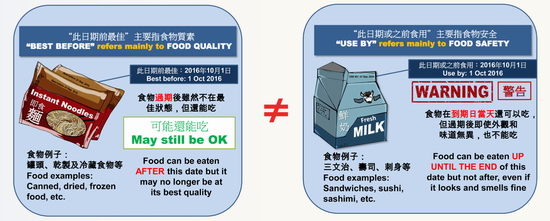
Food Safety Focus (122nd Issue, September 2016) – Food Safety Platform
Understanding Food Labels – "Best Before" VS "Use By" Dates
Reported by Ms. Janny MA,, Scientific Officer,
Risk Assessment Section,
Centre for Food Safety
Everyone should have experiences in buying food. However, some consumers may be confused about the wordings "best before" or "use by" together with the date listed.
Date Marking
In Hong Kong, a set of food law has been developed and implemented to ensure food safety. In order to help consumers make safe and optimum use of food, local regulation which is in line with standards adopted in other places, e.g. Australia, New Zealand and the European Union, requires prepackaged food to be legibly marked or labelled with an appropriate durability indication, i.e. a "best before" or "use by" date.
Common Misconceptions
X "Best before" and "use by" dates are the same.
Fact: A "best before" date relates to food quality. If the food is stored properly, it can reasonably be expected to retain its specific properties up to and including the specified date. Yet, a "use by" date relates to food safety. From microbiological point of view, the food is highly perishable and is therefore likely after a short period to constitute an immediate danger to human health.
X It is unsafe to eat any food beyond the designated date regardless it is "best before" or "use by".
Fact: After the "use by" date, the food may be unsafe to eat (due to the presence and/or excessive growth of harmful microorganisms as well as toxins produced by food poisoning microorganisms) even if it looks and smells fine. However, beyond the "best before" date, the food may still be acceptable to eat though it may have lost some of its quality, e.g. a loaf of plain bread after its "best before" date may still be safe to eat but may become dry and leathery.
X Certain type of food should carry a particular type of date mark.
Fact: Currently, there is no definitive list of which foods should carry a particular type of date mark. As traders, particularly the manufacturers, are the ones who understand the properties of their products best, they have the responsibility to set the appropriate date mark for consumers to make informed food choices. They should consult with technical experts on the microbiological risks posed by their products before giving a "use by" or "best before" date mark.
Storage Directions
When special conditions are required for the storage of food, on top of a "use by" or "best before" date, storage directions should also be included in food labels to ensure the food is properly handled by consumers. It is because if the food is not stored correctly, food poisoning bacteria such as Salmonella spp. and Listeria monocytogenes can grow to levels that may cause illness, even well before the date on the package. For instance, if a pack of ready-to-eat refrigerated deli meat is taken out of the fridge and left at room temperature for several hours, it will no longer be safe for consumption thereafter, even if the date has not expired.
These directions may also indicate how to store the food once the package is opened (e.g. "Refrigerate after opening", "Consume within seven days"). It should also be noted that both "use by" and "best before" dates apply only to unopened products. Once opened, the durability of a food may change!
Advice to the Public
- Take note of the "use by" or "best before" date of the food items before purchase or consumption.
- Do not eat nor donate food beyond its "use by" date, and be wary of the quality of food beyond the "best before" date.
- Always follow manufacturer's direction for proper storage.
Advice to the Trade
- Do not sell food nor give away food after its "use by" date.
- Ensure food sold after its "best before" date is still fit for human consumption.
- Consult with technical experts before giving a "use by" or "best before" date mark for a food.



